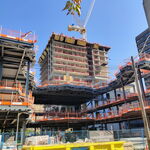Monarch Butterfly
Superstar
Perhaps. I don't know if current signal logic allows for that. Some municipalities default some signals to 'main route priority' during certain hours, but that requires sensors on the secondary route.
In Toronto, sensors are only for motor vehicles. In Europe, they have sensor or motion sensors so that pedestrians can activate their walk signal. Many times, I see pedestrians waiting almost forever for the signal to change, or they walk when the motor vehicles get a green light.




